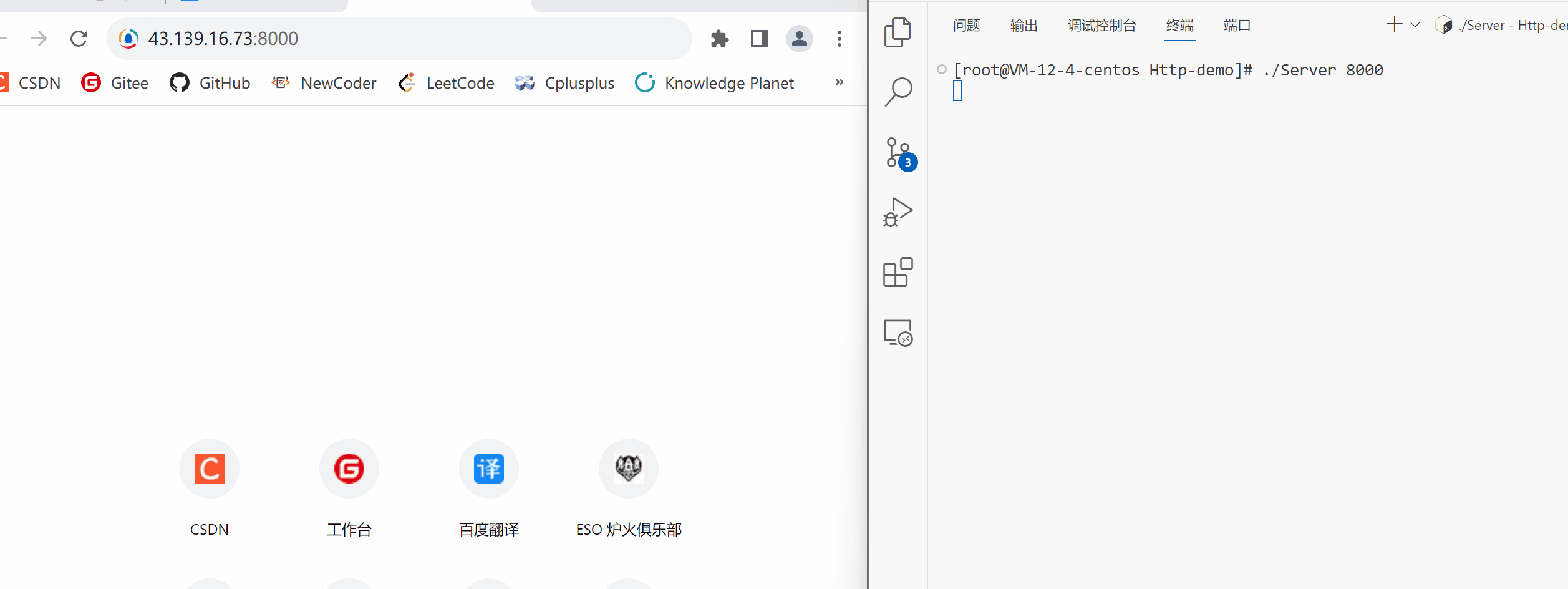认识http的方法、Header、状态码以及简单实现一个http的业务逻辑
文章目录
- http的方法
- http状态码
- http重定向
- http常见Header
- 实现简单业务逻辑
-
- Protocol.hpp
- Util.hpp
- Server.hpp
- Server.cc
- 效果
http的方法
| 方法 | 说明 | 支持的HTTP版本 |
|---|---|---|
| GET | 获取资源 | 1.0/1.1 |
| POST | 传输实体主体 | 1.0/1.1 |
| PUT | 传输文件 | 1.0/1.1 |
| HEAD | 获得报文首部 | 1.0/1.1 |
| DELETE | 删除文件 | 1.0/1.1 |
| OPTIONS | 询问支持方法 | 1.1 |
| TRACE | 追踪路径 | 1.1 |
| CONNECT | 要求用隧道协议连接代理 | 1.1 |
| LINK | 建立和资源之间的联系 | 1.0 |
| UNLINE | 断开连接关系 | 1.0 |
其中最为常见的请求方法为:GET POST
事实上,浏览器向服务器进行数据提交时,本质是前端通过form表单提交的,浏览器会自动将form表单中的内容转换为GET/POST的方法请求
例如在QQ的网址上会有登陆框,查看登陆框的源代码就会发现有form表单
如果输入了账号密码之后点击了登陆按钮,浏览器就会将账号和密码根据指定的GET或者POST方法发送给服务器。
其中两者的区别有:
- GET方法会将获取到的数据作为参数直接通过url 传递,也就是说GET方法会在url 上直接显示出数据,格式为:http://ip:port/XXX/YY?name=value&name2=value2。会直接暴露出数据
- POST方法不是通过url 传递数据,而是直接向请求的正文里提交数据。也就是说参数会存在在正文里,服务器再从正文里提取参数
- 因为GET方法是再url中直接传递参数,所以参数不能太大
- POST在正文传递参数,所以可以参数很大
需要注意的是:
虽然POST方法不会暴露数据,但是并不意味着就是安全的。私密 != 安全。
如果要谈到安全,那就必须要加密,加密内容属于https协议
http状态码
| 类别 | 原因 | |
|---|---|---|
| 1XX | informational - 信息性状态码 | 接受的请求正在处理 |
| 2XX | success - 成功状态码 | 请求正常处理完毕 |
| 3XX | redirection - 重定向状态码 | 需要进行附加操作以完成请求 |
| 4XX | client error - 客户端错误状态码 | 服务器无法处理请求 |
| 5XX | server error - 服务端错误状态码 | 服务器处理请求出错 |
其中最常见的就是 404 网页不存在
200 代表OK,404 Not Found,403 Forbiden,302 Redirect 重定向,504 Bad Gateway
http重定向
要实现重定向其实很简单,将状态码修改为307代表重定向,然后在正文里加入重定向的网址即可,这样向服务器请求后,服务器就会将处理的请求重定向到指定的网址
// 服务端处理的回调函数
bool func(const HttpRequest &req, HttpResponse &res)
{
// 打印方便调试查看接收到的数据是否正确
cout << "---------------http--------------" << endl;
cout << req._inbuffer;
cout << "_method: " << req._method << endl;
cout << " _url: " << req._url << endl;
cout << " _httpversion: " << req._httpversion << endl;
cout << " _path: " << req._path << endl;
cout << " _suffix: " << req._suffix << endl;
cout << " _size: " << req._size << endl;
cout << "---------------end---------------" << endl;
// 状态行
// string resline = "HTTP/1.1 200 OK\r\n";
string resline = "HTTP/1.1 307 Temporary Redirect\r\n";
// 响应报头
// 需要注意正确的给客户端返回资源,图片是图片,网页是网页
string rescontet = Util::suffixToDesc(req._suffix);
// 添加资源长度到报头
rescontet += "Content-Length: ";
rescontet += to_string(req._size);
rescontet += "\r\n";
// 添加重定向
rescontet += "Location: https://www.qq.com/\r\n";
// 空行
string resblank = "\r\n";
// 响应正文
string body;
// 判断资源是否存在,不存在就返回错误状态码 - 404
if (!Util::FileIsNo(req._path, &body))
{
Util::FileIsNo(errorhtml, &body);
}
// 写回响应的数据,后续要发送回客户端
res._outbuffer += resline;
res._outbuffer += rescontet;
res._outbuffer += resblank;
res._outbuffer += body;
return true;
}
http常见Header
| 名称 | 意义 |
|---|---|
| Content-Type | 数据类型(text/html等) |
| Content-Length | Body的长度 |
| Host | 客户端告知服务器, 所请求的资源是在哪个主机的哪个端口上 |
| User-Agent | 声明用户的操作系统和浏览器版本信息 |
| referer | 当前页面是从哪个页面跳转过来的 |
| location | 搭配3xx状态码使用, 告诉客户端接下来要去哪里访问 – 重定向 |
| Cookie | 用于在客户端存储少量信息. 通常用于实现会话(session)的功能 |
实现简单业务逻辑
代码里涉及html代码,不详细讲解
由于服务器较弱,所以图片获取直接从网址获取,不从服务器读取
需要注意,一个网页看到的结果,可能是有多个资源组合而成,例如有网页,图片,视频等。所以要获取一张完整的网页效果需要浏览器发送多次请求,那么服务器就要根据请求的类型不同对响应正文处理的方式要指明Content-Type的类型。例如网页为“text/html”,jpg格式的图片为“image/jpeg”,不同的格式可自行搜索
判断格式的方法可以根据 url 中资源的后缀进行判断
以下代码均有注释:
Protocol.hpp
请求响应类
因为浏览器会自动处理收到的响应报文,所以不需要编写处理方法只需要将响应报文发送回浏览器即可
#pragma once
#include Util.hpp
工具类,将共有的方法定义同个类,方便调用
#pragma once
#include Server.hpp
#pragma once
#include "Protocol.hpp"
#include Server.cc
#include "Server.hpp"
#include 效果
在此就不写出html的文件了,看着效果能够实现即可
可以看到浏览器向服务器发送请求,服务器返回响应,响应里就包括了自己编写的html文件,所以浏览器处理后就显示出了自己的网页

